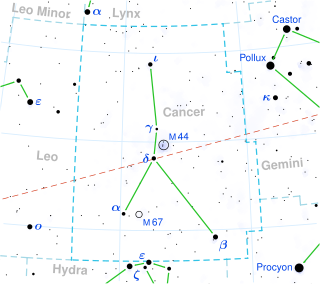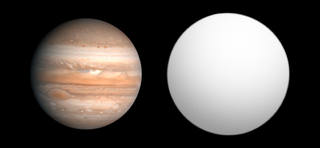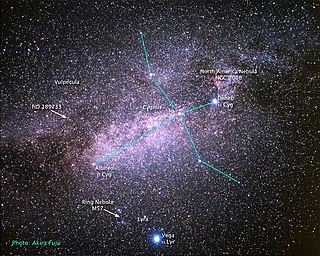Related Research Articles

55 Cancri is a binary star system located 41 light-years away from the Sun in the zodiac constellation of Cancer. It has the Bayer designation Rho1 Cancri (ρ1 Cancri); 55 Cancri is the Flamsteed designation. The system consists of a K-type star and a smaller red dwarf.

TrES-1b is an extrasolar planet approximately 523 light-years away in the constellation of Lyra. The planet's mass and radius indicate that it is a Jovian planet with a similar bulk composition to Jupiter. Unlike Jupiter, but similar to many other planets detected around other stars, TrES-1 is located very close to its star, and belongs to the class of planets known as hot Jupiters. The planet was discovered orbiting around GSC 02652-01324.

Gliese 436 is a red dwarf approximately 31.8 light-years away in the zodiac constellation of Leo. It has an apparent visual magnitude of 10.67, which is much too faint to be seen with the naked eye. However, it can be viewed with even a modest telescope of 2.4 in (6 cm) aperture. In 2004, the existence of an extrasolar planet, Gliese 436b, was verified as orbiting the star. This planet was later discovered to transit its host star.

HD 189733, also catalogued as V452 Vulpeculae, is a binary star system approximately 64.5 light-years away in the constellation of Vulpecula. The primary star is suspected to be an orange dwarf star, while the secondary star is a red dwarf star. Given that this system has the same visual magnitude as HD 209458, it promises much for the study of close transiting extrasolar planets. The star can be found with binoculars 0.3 degrees east of the Dumbbell Nebula (M27).

HD 80606 and HD 80607 are two stars comprising a binary star system. They are approximately 217 light-years away in the constellation of Ursa Major. Both stars orbit each other at an average distance of 1,200 astronomical units. The binary system is listed as Σ1341 in the Struve Catalogue of Double Stars; however, this designation is not in wide use and the system is usually referred to by the HD designations of its constituent stars. An extrasolar planet has been confirmed to orbit HD 80606 in a highly elliptical orbit.
The XO Telescope is an astronomical telescope located on the 3,054 m summit of Haleakala on Maui, Hawaii. It consists of two 200-millimeter telephoto camera lenses, and resembles binoculars in shape. It is used by the XO Project to detect extrasolar planets using the transit method. It is similar to the TrES survey telescope. The construction of the one-of-a-kind telescope cost $60,000 for the hardware, and much more than that for the associated software.

XO-1 is a magnitude 11 G-type main-sequence star located approximately 530 light-years away in the constellation Corona Borealis. XO-1 has a mass and radius similar to the Sun. In 2006 the extrasolar planet XO-1b was discovered orbiting XO-1 by the transit method using the XO Telescope.

XO-1b is an extrasolar planet approximately 536 light-years away from Earth.
The Hungarian Automated Telescope Network (HATNet) project is a network of six small fully automated "HAT" telescopes. The scientific goal of the project is to detect and characterize extrasolar planets using the transit method. This network is used also to find and follow bright variable stars. The network is maintained by the Center for Astrophysics | Harvard & Smithsonian.

XO-3b is an exoplanet with about 11.79 times the mass of Jupiter, and it orbits its parent star in about 3.2 days. The radius of this object is 1.217 times that of Jupiter. Astronomers announced their discovery on May 30, 2007, at the American Astronomical Society in Honolulu, Hawaii. Its discovery is attributed to the combined effort of amateur and professional astronomers working together on the XO Project using a telescope located on the Haleakala summit in Hawaii.
HD 17156, named Nushagak by the IAU, is a yellow subgiant star approximately 255 light-years away in the constellation of Cassiopeia. The apparent magnitude is 8.17, which means it is not visible to the naked eye but can be seen with good binoculars. A search for a binary companion star using adaptive optics at the MMT Observatory was negative.
HAT-P-6 also named Sterrennacht is a star in the constellation Andromeda, located approximately 895 light years or 274 parsecs away from the Earth. It is an F-type star, implying that it is hotter and more massive than the Sun. The apparent magnitude of the star is +10.54, which means that it can only be visible through the telescope. The absolute magnitude of +3.36 is brighter than the Sun's +4.83, meaning that the star itself is brighter than the Sun. A search for a binary companion star using adaptive optics at the MMT Observatory turned out negative.

HAT-P-6b is a transiting extrasolar planet discovered by Noyes et al. on October 15, 2007. It is located approximately 910 light-years away in the constellation of Andromeda, orbiting the star HAT-P-6. This hot Jupiter planet orbits with a semi-major axis of about 7.832 gigameters, and takes 92 hours, 28 minutes, 17 seconds and 9 deciseconds to orbit the star. It has true mass of 5.7% greater than Jupiter and a radius 33% greater than Jupiter, corresponding to a density of 0.583 g/cm3, which is less than water.

WASP-4b is an extrasolar planet approximately 891 light-years away in the constellation of Phoenix.
XO-5 is a yellow dwarf main sequence star located approximately 910 light-years away from Earth in the Lynx constellation. It has a magnitude of about 12 and cannot be seen with the naked eye but is visible through a small telescope.
XO-2 is a binary star. It consists of two components: XO-2S and XO-2N.
XO-4 is a star located approximately 896 light-years away from Earth in the Lynx constellation. It has a magnitude of about 11 and cannot be seen with the naked eye but is visible through a small telescope. A search for a binary companion star using adaptive optics at MMT Observatory was negative.

HAT-P-14b, also known as WASP-27b, is an extrasolar planet located approximately 224.2 ± 0.6 parsecs (731.2 ± 2.0 ly) away in the constellation of Hercules, orbiting the 10th magnitude F-type main-sequence star HAT-P-14. This planet was discovered in 2010 by the HATNet Project using the transit method. It was independently detected by the SuperWASP project.
HAT-P-17 is a K-type main-sequence star about 92.6 parsecs (302 ly) away. It has a mass of about 0.857 ± 0.039 M☉. It is the host of two planets, HAT-P-17b and HAT-P-17c, both discovered in 2010. A search for a binary companion star using adaptive optics at the MMT Observatory was negative. A candidate companion was detected by a spectroscopic search of high-resolution K band infrared spectra taken at the Keck observatory.
Kepler-13 or KOI-13 is a stellar triple star system consisting of Kepler-13A, around which an orbiting hot Jupiter exoplanet was discovered with the Kepler spacecraft in 2011, and Kepler-13B a common proper motion companion star which has an additional star orbiting it.
References
- ↑ Roman, Nancy G. (1987). "Identification of a Constellation From a Position". Publications of the Astronomical Society of the Pacific. 99 (617): 695–699. Bibcode:1987PASP...99..695R. doi: 10.1086/132034 . Vizier query form
- 1 2 3 4 5 Vallenari, A.; et al. (Gaia Collaboration) (2022). "Gaia Data Release 3. Summary of the content and survey properties". Astronomy & Astrophysics . arXiv: 2208.00211 . doi: 10.1051/0004-6361/202243940 . Gaia DR3 record for this source at VizieR.
- 1 2 3 4 5 6 Johns-Krull, Christopher M.; et al. (2008). "XO-3b: A Massive Planet in an Eccentric Orbit Transiting an F5V Star". The Astrophysical Journal. 677 (1): 657–670. arXiv: 0712.4283 . Bibcode: 2008ApJ...677..657J . doi: 10.1086/528950 . S2CID 15342571.
- 1 2 3 Cutri; et al. (2003). "2MASS===04215269+5749018". 2MASS All-Sky Catalog of Point Sources. Retrieved 2012-02-25.
- 1 2 3 4 5 6 7 8 Winn, Joshua N.; et al. (2008). "The Transit Light Curve Project. IX. Evidence for a Smaller Radius of the Exoplanet XO-3b". The Astrophysical Journal. 683 (2): 1076–1084. arXiv: 0804.4475 . Bibcode:2008ApJ...683.1076W. doi:10.1086/589737. S2CID 119266744.
- ↑ "SIMBAD query result: TYC 3727-1064-1 -- Star". Centre de Données astronomiques de Strasbourg. Retrieved 2012-02-25.
- ↑ Adams, E. R.; et al. (2013). "Adaptive Optics Images. II. 12 Kepler Objects of Interest and 15 Confirmed Transiting Planets". The Astronomical Journal. 146 (1). 9. arXiv: 1305.6548 . Bibcode:2013AJ....146....9A. doi:10.1088/0004-6256/146/1/9. S2CID 119117620.
- ↑ "XO-3b: Supersized planet or oasis in the 'brown dwarf desert'?" (Press release). Houston, Texas: Rice University. 2007-06-30. Retrieved 2022-01-01.
- ↑ Winn, Joshua N.; et al. (2009). "On the Spin-Orbit Misalignment of the XO-3 Exoplanetary System". The Astrophysical Journal. 700 (1): 302–308. arXiv: 0902.3461 . Bibcode:2009ApJ...700..302W. doi:10.1088/0004-637X/700/1/302. S2CID 2358804.
- ↑ Hirano, Teruyuki; et al. (2011). "Further Observations of the Tilted Planet XO-3: A New Determination of Spin-Orbit Misalignment, and Limits on Differential Rotation". Publications of the Astronomical Society of Japan. 63 (6): L57–L61. arXiv: 1108.4493 . Bibcode:2011PASJ...63L..57H. doi:10.1093/pasj/63.6.l57. S2CID 16909722.